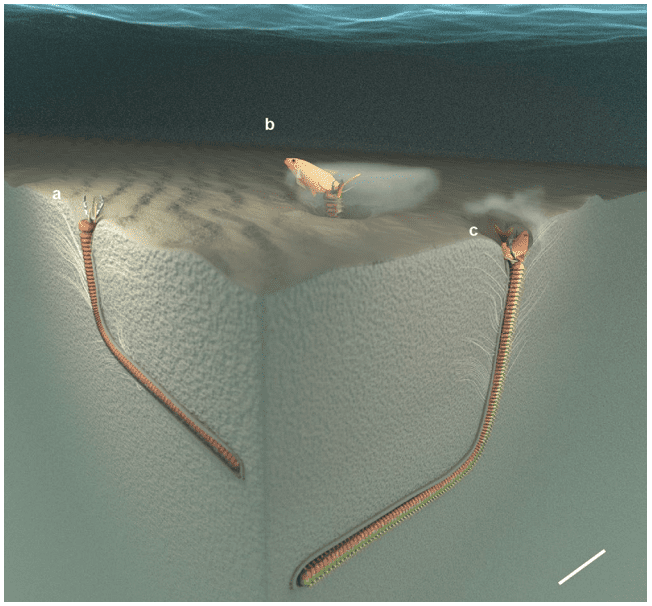Fossil hunters in Taiwan have found the undersea lair of an ancient, predatory giant worm. The 20-million-year-old animal grew to be 2 meters (6.6 ft) long and ambushed unsuspecting prey and dragged them down to its burrow.

The worm might have been similar to Eunice aphroditois, modern ambush predator worms that hunt using a similar approach. Although it’s not possible to tell if these two species were related by the fossil alone, it’s still a spectacular find.
Ancient murder macaroni
“After 20m years, it’s not possible to say whether this was made by an ancestor of the bobbit worm [Eunice aphroditois] or another predatory worm that worked in more or less the same way,” said Prof Ludvig Löwemark, a sedimentologist at National Taiwan University and co-author of the paper.
“There’s huge variation in bobbit worm behaviour, but this seems very similar to the shallow water worms that reach out, grab fish and pull them down.”
Although they’re soft-bodied like other worms, these predatory worms have sharp, powerful jaws that can pack quite a punch. The fossil worm likely hunted in a similar fashion, but for now we can only hypothesize.
What the team found isn’t a fossil of the worm itself (soft tissues don’t fossilize and worms are basically entirely soft tissue), rather, they found the fossil of its burrow. Löwemark and his colleagues discovered it while studying sedimentary rocks on the north-eastern coast of Taiwan that hail from around the same time as the worm. If they’re anything like today’s worm burrows, these were reinforced with mucus produced by the worm to make them more resilient.
Today, the fossil burrows sometimes simply protrude from the sandstone they formed in, suggesting that they’re harder than the rock and supporting the mucus-reinforcement hypothesis.
Although the team was initially confused as to what these were, they noticed a distinctive pattern at the top of the 3 cm-wide structures. This looked like several inverted funnels that got stacked on top of one another, they explain, giving the opening of the structures a feathered look in cross-section.

These marks allowed the team to rule out burrowing creatures such as shrimp or stingrays as the builders. Finally, the only remaining possibility was that of an animal behaving like today’s predatory worms. The structures at the top, the team notes, is produced by repeated rebuilding of the lair as it collapses every time the worms pull prey in.
“This results in the stack of cone-in-cone structures that form the ‘feathers’ around the uppermost part of the tube,” said Löwemark.
The team reports they’ve found 319 such burrows in sandstone formations from the Yehliu Geopark and on the nearby Badouzi promontory, suggesting that the area was heavily populated with these worms in the past. They’ve named the trace fossil burrows Pennichnus formosae.
Although they hoped to find fossilized remains of the worms themselves or their prey, the team hasn’t been so lucky yet.
The paper “The 20-million-year old lair of an ambush-predatory worm preserved in northeast Taiwan” has been published in the journal Scientific Reports.
https://news.google.com/__i/rss/rd/articles/CBMiVmh0dHBzOi8vd3d3LnptZXNjaWVuY2UuY29tL3NjaWVuY2UvZm9zc2lsLWZyaWRheS1hbmNpZW50LXByZWRhdG9yeS13b3JtLWJ1cnJvdy05MzQ2MzMv0gFaaHR0cHM6Ly93d3cuem1lc2NpZW5jZS5jb20vc2NpZW5jZS9mb3NzaWwtZnJpZGF5LWFuY2llbnQtcHJlZGF0b3J5LXdvcm0tYnVycm93LTkzNDYzMy9hbXAv?oc=5
2021-01-22 17:10:52Z
52781320591187
Tidak ada komentar:
Posting Komentar